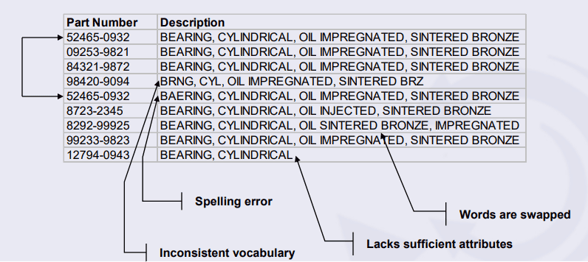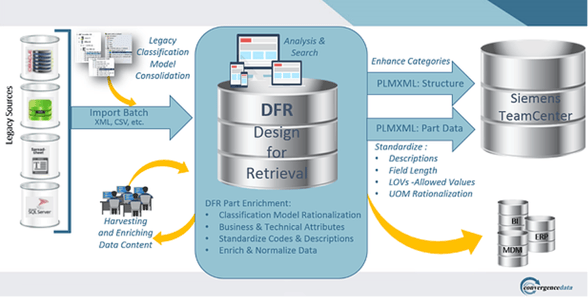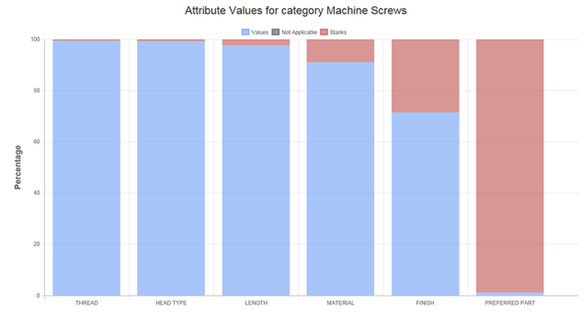3 Steps to Better Teamcenter Data Migrations
With over two decades of experience working with large Product Lifecycle Management (PLM) landscapes including the Siemens Teamcenter solution, the Convergence Data team is a proud Siemens partner. We've tackled many Teamcenter use cases over the years and help organizations with classification and enrichment of their purchased parts to enable parts data to be leveraged more strategically, including supplier spend rationalization, promoting reuse of parts, reducing duplication within the PLM parts estate, and more! ⚙️
We have good news and bad news about Teamcenter. 😯
The good news is that Teamcenter® software from Siemens is a modern, adaptable product lifecycle management (PLM) system. It connects your people and processes across functional silos, helping you solve the tough challenges of developing highly successful products.
The bad news is that Teamcenter is only as useful as the data you put into it. “Garbage in, garbage out,” as they say. So how, exactly, do you prevent bad data from getting into Teamcenter? By planning, organizing classification models, and conducting up-front data cleaning in a staging environment. Here’s how. 👇
First, Let’s Define Good and Bad Data
At its most basic, the data you are working with consists of a part number and a description. That data might be recent, or it may have been entered into your system years (even decades) ago.
If your company is like many others, you have been acquired or you have acquired other companies over the years. Or maybe, one or more companies have merged with yours.
➡️All of this acquisition and mergers activity means a merging of products—and product data. And this means that your product data over time has likely degraded in quality. Poor data is:
- Inconsistent
- Duplicated but easy to recognize
- Duplicated but not easy to recognize
- Lacking enough information to determine the characteristics of the product
The most common cause of poor data is lack of useful information. This leaves you with ambiguous descriptions and erroneous data, making it hard to differentiate one part from another.
Add to this the other complicating factors: Product data can be scattered across many locations, in many formats, and in multiple databases across a company.
Clean data, on the other hand, is complete, accurate, and easy to use. Products are grouped and easy to find by their characteristics, leading to higher reuse. With clean data, duplicate items are easy to see. And you can analyze the data for consolidation, strategic sourcing and other purposes. 🔎
Step 1. Use a Standard Classification Structure
Whether you are migrating several systems to one existing system or doing a new migration, you should have a staging system (see below) where you consolidate classification structures, harvest and enrich data, and then normalize and validate the data.
A data migration model within the Convergence Data Design for Retrieval software staging area.
Classification is the organizational structure of the data. If the organizational structure is too complex or disparate, then the operational usefulness of the data will also be too complex or disparate for the end users. Use a staging environment to develop the classification structure until it works for your company.
The best staging areas allow for search and analysis in the staging data so you can perform detailed models and tests on the retrieval of information of that structure. The best data structure starts with the end in mind. You determine the end by determining the reporting and search needs that are driven by the structure.
Also, consider merging your classifications. For example, you may have a classification that works for you, but you need to make a new branch to incorporate new parts from an acquisition or merger of systems. Adding to existing class structures can be messy, but with a staging area you can start with the classification you want to keep today and use the staging area to modify and play with additional branches of the tree.
To merge your classifications, first load your classification structures using PLMXML, XML, and/or Excel spreadsheets from other systems into the staging area. Then use the flexible staging area to play with the structure until it meets your needs.
Follow Best Practices When Classifying Your Parts
You want to get the most value from your classification project. Follow these seven best practices for a parts classification project and you will stay on track.
- Target high-value parts for classification, starting with your top 10 categories.
- Pull all parts from each organization for each category.
- Assign one engineering SME and one purchasing category owner for each commodity to approve structure and data.
- For each part, provide part number, part description, MFG part number and MFG name, drawing or specification.
- Obtain commercial data for each part (pricing, supplier names, buying volumes).
- Look for clustering opportunities that lower your procurement costs.
- Validate your data against the PLM systems rules before loading it.
Step 2. Harvest and Enrich with Attribute Data
Once you have built your classification structure, populate the data to its fullest extent. The classification structure and search/reporting needs will identify which attributes are key to data extraction. You should populate those key attributes as close to 100% as possible. You can then populate the other attributes with available supporting data.
Your staging area should have reporting to identify attribute population. Proper and complete population of attributes is imperative to good search and reporting within Teamcenter. You should use staging search and reporting tools to show how the data will look once it is imported into the final Teamcenter location.
Remember that the next step after classifying your parts into categories is to enrich them with valuable attribute data. You do this by determining the most important attributes for the parts you are clustering. These are your key attributes, the critical attributes that you will use to find the parts you need. Look for key attributes that have good fill rates and that are normalized before you cluster.
Step 3. Normalize, Validate and Export the Data
Once the structure is in place and you have harvested the attributes, streamline the data for maximum use. Do this in four stages.
- Normalize – Ensure you have reviewed the data in the attributes and normalized them to standard nomenclature. Otherwise, your data won’t show accurately in reports.
- Validate – Review the data quality and ensure its export readiness by reviewing things like units of measure and field lengths on the attribute fields. Pay particular attention to those fields that are limited in a PLM like Teamcenter.
- De-Duplicate – Inevitably, you will end up with duplicate parts. But now that the parts are cleaned and attributes are populated, identifying those duplicates and removing them is a lot easier.
- Export – Once your data passes validations, you are ready to export to Teamcenter.
Plan to organize and clean your data in a staging area before you begin your migration process. Always have the end in mind when cleaning data. Create a consolidated classification model and harvest key attributes so that the deployment of your PLM system goes smoothly.
Find a Valuable Partner for Teamcenter Data Migrations
Companies with chaotic or incomplete data trust Convergence Data to scrub that information into an organized, efficient structure. We specialize in:
- Minimizing part duplication.
- Cultivating part standardization and re-use.
- Reducing part count.
- Streamlining inventories.
- Improving leverage with vendors.
- PLM/PIM migrations.
Convergence Data enables customers to manage data in a variety of industries, including Aerospace and Defense, Appliances, Automotive, Electronics, Industrial Manufacturing, and Oilfield Services.
For companies deploying PLM solutions, the cleansing, classification, and data enrichment services from Convergence Data can be a significant benefit. To speak with a PLM data expert and receive a Data Value Analysis (DVA), contact us today.
Looking for help with classifying and enriching your purchased parts for Teamcenter? Not sure how to get started? Contact us today! ✏️





